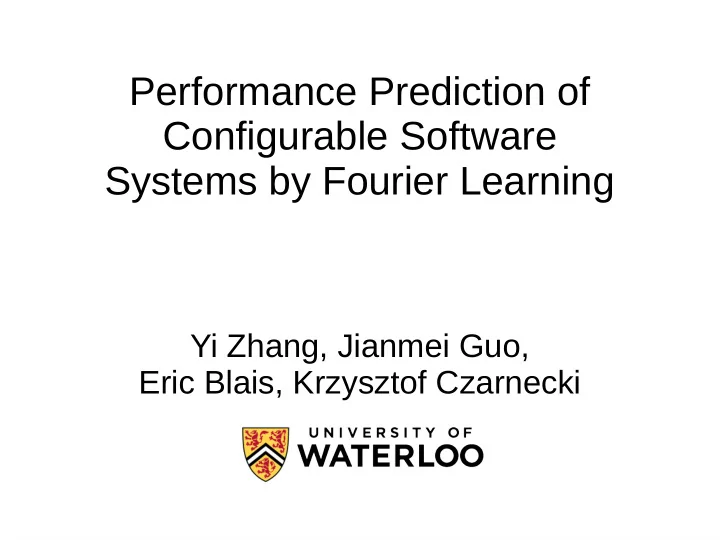

Performance Prediction of Configurable Software Systems by Fourier Learning Yi Zhang, Jianmei Guo, Eric Blais, Krzysztof Czarnecki
Overview ● The Problem ● The Tool ● The Solution ● Evaluation 2
The Problem ● Given configurable software systems with n (binary) features ● Each configuration is a set of features ● Each configuration has a performance value, e.g. execution time ● Goal: Predict the performance of all (valid) configurations by measuring a (small) sample of configurations. 3
The Problem: Example Feature_1 Feature_2 Feature_3 Performance 1 0 0 7.0 0 1 1 5.9 1 1 0 8.1 0 0 1 ? ... ... ... ? 1 1 1 ? 4
The Problem: Alternative x f(x) x_1 x_2 x_3 1 0 0 7.0 0 1 1 5.9 1 1 0 8.1 0 0 1 ? ... ... ... ? 1 1 1 ? 5
The Problem: Alternative ● Given n, the number of features n ● Configuration: bit vector x ∈{ 0,1 } ● Performance: f(x) n ● Goal: Estimate f(x) for all x ∈{ 0,1 } i.e. learn the function f 6
The Challenge This is impossible for arbitrary f ! f(101) has nothing to do with f(110) 7
The Good News: Functions representing real software systems have structure . 8
The Tool: Fourier Analysis n →ℝ f : { 0,1 } Given a function: Can write f as: where: 9
The Tool: Observations n →ℝ f : { 0,1 } ● For a function n 2 There are Fourier coefficients ● Knowing the coefficients is equivalent to knowing the function itself. 10
The Tool: Example x f(x) 0 0 3 0 1 2 1 0 4 1 1 1 f ( x )= 2.5 ⋅χ 00 ( x )+ 1 ⋅χ 01 ( x ) + 0 ⋅χ 10 ( x )+(− 0.5 ) ⋅χ 11 ( x ) 0 11
The Tool: Fourier Analysis f ( z )= 1 ^ n ∑ x ∈{ 0,1 } n f ( x )⋅χ z ( x ) 2 For example: f ( 01 )= 1 ^ 4 ( f ( 00 ) ⋅χ 01 ( 00 )+ f ( 01 ) ⋅χ 01 ( 01 ) + f ( 10 )⋅χ 01 ( 10 )+ f ( 11 ) ⋅χ 01 ( 11 )) f ( 01 )= 1 ^ 4 ( 3 − 2 + 4 − 1 )= 1 12
The Good News: Functions representing real software systems have structure are Fourier sparse! (when normalized) i.e. many coefficients are (close to) 0 . 13
The Problem: Final ● Given n, the number of features n ● Configuration: bit vector x ∈{ 0,1 } ● Performance: f(x) n ● Goal: Estimate f(x) for all x ∈{ 0,1 } Estimate all (large) Fourier coefficients of f . 14
The Solution: Idea f ( z )= 1 ^ n ∑ x ∈{ 0,1 } n f ( x )⋅χ z ( x ) 2 Take random sample S : h ( z )≈ 1 | S | ∑ ^ f ( x ) ⋅χ z ( x ) (*) x ∈ S ^ h h ( z ) Use to construct 15
The Solution: Theorem (Hoeffding) Given f is Fourier-sparse, if S is large, then h is close to f with high probability. 16
The Solution: Theorem n →ℝ f : { 0,1 } Given is Fourier t-sparse, with 2 2 (( n + 1 ) log ( 2 )+ log ( 1 δ )) ϵ samples, our estimation h can achieve: 2 < t ⋅ϵ 2 ‖ f − h ‖ 1 −δ with probability . 17
The Solution: Algorithm γ 1) User specify error bound and confidence level 2) Assume t = 1 ( f is 1-sparse), and calculate number of samples required 3) Take the measurements and calculate Fourier coefficients using (*), obtain h 4) Take more samples and estimate the distance between h and f 5) If not within the specified bound, increase t and repeat 18
Evaluation: Systems |D| = # Total configurations. Original systems too small. 19
Evaluation: Hybrid-systems System x*y x y f(x*y) x_1 x_2 y_1 y_2 f(x)+f(y) 0 0 0 0 3+2 0 0 0 1 3+4 0 0 1 0 3+1 ... ... ... ... ... 1 1 1 1 5+3 20
Evaluation: Systems |D| = # Total configurations. 21
Evaluation: Results 1) Confidence level set to be 80% 2) Run 10 times for each setting 22
Evaluation: Comparison 1) SPLConqueror from Siegmund et. al.(2012) uses feature interaction to predict performance. 2) CART from Guo et. al. (2013) uses machine learning techniques. SPLConqueror CART Fourier Accuracy ~ 95% ~ 94% Arbitrary* 2 ) O ( n 2 ) Sample Size Any O ( n, 1 / γ Sampling Specific Random Random Error Control No No Yes System Any Any Large 23
Summary 1) Fourier learning predicts software performance with guaranteed accuracy and confidence level 2) May require large systems and run time may be slow 3) Future: reduce exponential number of Fourier coefficient estimations 4) Future: testing Fourier sparse-ness of systems 24
Thank you. 25
Recommend
More recommend